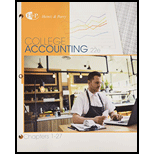
Bundle: College Accounting, Chapters 1-27, Loose-Leaf Version, 22nd + CengageNOWv2, 2 terms Printed Access Card
22nd Edition
ISBN: 9781305930421
Author: James A. Heintz, Robert W. Parry
Publisher: Cengage Learning
expand_more
expand_more
format_list_bulleted
Question
Chapter 24, Problem 6SEA
To determine
Compute Return on equity during the period 20-2 using its three components.
Expert Solution & Answer
Want to see the full answer?
Check out a sample textbook solution
Students have asked these similar questions
What does the selling price per unit need to be?
General accounting question
Soultion
Chapter 24 Solutions
Bundle: College Accounting, Chapters 1-27, Loose-Leaf Version, 22nd + CengageNOWv2, 2 terms Printed Access Card
Ch. 24 - A comparison of amounts for the same item in the...Ch. 24 - Prob. 2TFCh. 24 - Prob. 3TFCh. 24 - Prob. 4TFCh. 24 - Prob. 5TFCh. 24 - Prob. 1MCCh. 24 - Prob. 2MCCh. 24 - Working capital is a measure of (a) liquidity. (b)...Ch. 24 - Prob. 4MCCh. 24 - Prob. 5MC
Ch. 24 - Prob. 1CECh. 24 - Prob. 2CECh. 24 - Compute the following profitability measures for...Ch. 24 - Prob. 4CECh. 24 - Prob. 5CECh. 24 - Prob. 6CECh. 24 - Prob. 1RQCh. 24 - Prob. 2RQCh. 24 - Prob. 3RQCh. 24 - Prob. 4RQCh. 24 - Prob. 5RQCh. 24 - Prob. 6RQCh. 24 - Prob. 7RQCh. 24 - Prob. 8RQCh. 24 - Prob. 9RQCh. 24 - Prob. 10RQCh. 24 - Prob. 11RQCh. 24 - Prob. 12RQCh. 24 - Prob. 13RQCh. 24 - Prob. 1SEACh. 24 - Prob. 2SEACh. 24 - ANALY SIS OF PROFITABILITY Based on the financial...Ch. 24 - ANALY SIS OF LEVERAGE Based on the financial...Ch. 24 - Prob. 5SEACh. 24 - Prob. 6SEACh. 24 - Prob. 7SEACh. 24 - Prob. 8SPACh. 24 - Prob. 9SPACh. 24 - RATIO ANALYSIS OF COMPARATIVE FINANCIAL STATEMENTS...Ch. 24 - Prob. 1SEBCh. 24 - ANALYSIS OF ACTIVITY MEASURES Based on the...Ch. 24 - Prob. 3SEBCh. 24 - Prob. 4SEBCh. 24 - Prob. 5SEBCh. 24 - Prob. 6SEBCh. 24 - Prob. 7SEBCh. 24 - Prob. 8SPBCh. 24 - Prob. 9SPBCh. 24 - RATIO ANALYSIS OF COMPARATIVE FINANCIAL STATEMENTS...Ch. 24 - Prob. 1MPCh. 24 - This problem challenges you to apply your...
Knowledge Booster
Similar questions
- Please explain the solution to this General accounting problem with accurate principles.arrow_forwardHello tutor provide correct answerarrow_forwardCher Industries has total material costs of $56,200, and total conversion costs are $74,600. The equivalent units of production are materials 18,250 and conversion costs 22,150. Compute the unit costs for materials and conversion costs.arrow_forward
- sub . general accountingarrow_forwardPlease get correct answer financial accountingarrow_forwardSavannah Construction reported beginning total assets of $1,100,000 and ending total assets of $1,200,000 for 2020. Its net income for this period was $520,000, and its net sales were $3,000,000. Compute the company's asset turnover for 2020.arrow_forward
arrow_back_ios
SEE MORE QUESTIONS
arrow_forward_ios
Recommended textbooks for you
 College Accounting, Chapters 1-27AccountingISBN:9781337794756Author:HEINTZ, James A.Publisher:Cengage Learning,Century 21 Accounting Multicolumn JournalAccountingISBN:9781337679503Author:GilbertsonPublisher:Cengage
College Accounting, Chapters 1-27AccountingISBN:9781337794756Author:HEINTZ, James A.Publisher:Cengage Learning,Century 21 Accounting Multicolumn JournalAccountingISBN:9781337679503Author:GilbertsonPublisher:Cengage Managerial AccountingAccountingISBN:9781337912020Author:Carl Warren, Ph.d. Cma William B. TaylerPublisher:South-Western College Pub
Managerial AccountingAccountingISBN:9781337912020Author:Carl Warren, Ph.d. Cma William B. TaylerPublisher:South-Western College Pub Financial And Managerial AccountingAccountingISBN:9781337902663Author:WARREN, Carl S.Publisher:Cengage Learning,
Financial And Managerial AccountingAccountingISBN:9781337902663Author:WARREN, Carl S.Publisher:Cengage Learning, Managerial Accounting: The Cornerstone of Busines...AccountingISBN:9781337115773Author:Maryanne M. Mowen, Don R. Hansen, Dan L. HeitgerPublisher:Cengage Learning
Managerial Accounting: The Cornerstone of Busines...AccountingISBN:9781337115773Author:Maryanne M. Mowen, Don R. Hansen, Dan L. HeitgerPublisher:Cengage Learning

College Accounting, Chapters 1-27
Accounting
ISBN:9781337794756
Author:HEINTZ, James A.
Publisher:Cengage Learning,

Century 21 Accounting Multicolumn Journal
Accounting
ISBN:9781337679503
Author:Gilbertson
Publisher:Cengage

Managerial Accounting
Accounting
ISBN:9781337912020
Author:Carl Warren, Ph.d. Cma William B. Tayler
Publisher:South-Western College Pub

Financial And Managerial Accounting
Accounting
ISBN:9781337902663
Author:WARREN, Carl S.
Publisher:Cengage Learning,


Managerial Accounting: The Cornerstone of Busines...
Accounting
ISBN:9781337115773
Author:Maryanne M. Mowen, Don R. Hansen, Dan L. Heitger
Publisher:Cengage Learning